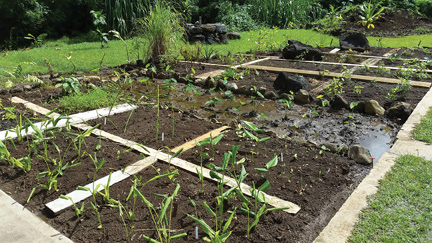
We live in a modernized society where convenience is key. With the push of a button, a prescription is filled. We are quick to run to the nearest grocery store when illness arises. But do you ever wonder about the harmful side effects caused by modern-day medicine? Did you know that there are natural and effective ways to treat and cure common illnesses?
In October, students of HWST 285: Lāʻau Lapaʻau (Hawaiian Medicinal Herbs), taught by Kumu Leinaʻala Bright, cultivated a māla (garden) consisting of over 30 different medicinal herbs located near Hale Aʻo. Every plant and tree in the māla can be used to treat or cure various ailments.
“I really think to learn about a plant you need to learn the lifecycle of the plant,” said Bright. “So for the class to be able to actually get the lepo (soil) ready and then start the plants and just kind of follow the plants growth, they’ll be able to recognize how to pick it and how to make medicine. A garden really helps us with that.”
Included in the māla is koʻokoʻolau (Bidens asymetrica/alba), a delicate and endangered native Hawaiian plant. The crushed leaves of the koʻokoʻolau can be made into an herbal tea used to treat stomach problems and prevent diabetes.
“For health, wellness and balance within our very busy lifestyles and all the different foods, stress and just the way life can be now, having a course like this, it gives you time to kind of restructure and take a break and you can go through the cleanses,” said Bright. “You can learn how to make medicine so you really start working on healing within for yourself and then it starts spreading out to the family and community.”

Bright collaborated with fellow lāʻau lapaʻau practioners Dr. Sol NaluaʻI and Poʻokela on the design and layout of the māla. Every plant was strategically placed according to its growth behavior and the sun’s daily movement.
Taller plants needing more sunlight were placed on the eastside of the garden. The pōhaku (rock) also serves a unique purpose. “One has a basin in it and that is for us to kuʻi (to pound) and make medicine in it,” said Bright. “And the other one is for sitting on.”
The māla’s irrigation system was ingeniously engineered by NaluaʻI. Rain gutters connected to an adjacent building provide water that runs off into a nearby catchment tank.
A spigot at the bottom of the tank allows water to flow down the pavement and into the garden.
A small trench was also dug to allow water to reach other plants within the māla. Any excess water is then naturally flushed out through a nearby drainage.
As a graduate of UH Mānoa and more than 20 years of experience as a lomilomi practitioner, Bright brings with her knowledge acquired from the teachings of the late Levon Ohai.
“Kumu Levon Ohai taught at UH Mānoa,” said Bright. “Those of us that are in the [Hawai‘i] university system teaching, are his students. So we teach his family practices [of lāʻau lapaʻau]. I did put in some of my own experiences too. Some of us have our plants which we favor. Pretty much the class is structured the way Kumu Ohai’s was. It’s really his manaʻo that we share.”
Within the lāʻau lapaʻau community, Ohai is a renowned kumu and kahuna (medicine doctor). Ohai created the Hawaiian medicinal courses and graduate program offered at UH-Mānoa.
The four-credit course at WCC teaches students necessary skills to prepare Hawaiian medicinal herbs. Students learn the fundamental beliefs and traditions surrounding these healing plants. “The course I teach is very flexible too,” said Bright. “I’ll change the course according to the needs of the students as far as health and well-being.”
Upon completion of the course, students gain knowledge that can be used in daily life. The prerequisite for the course is HWST 107 or BOT 105 or the instructor’s approval.
“It is an amazing course to have inside the university system because it’s a traditional practice that we’re teaching,” said Bright. “So for students to have access to traditional knowledge like that, like what we share, is unusual. It’s not one of those common classes you can take anywhere.”
by Tammy Pratt, Ka ‘Ohana Staff Reporter




